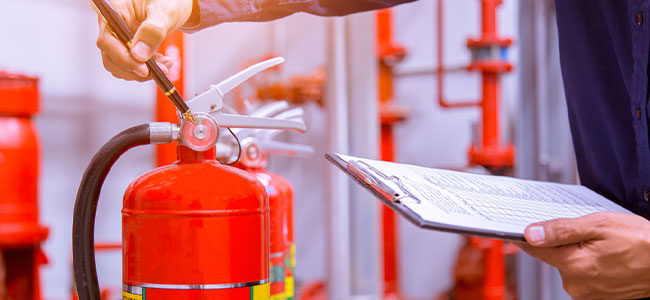
Dropping the Ball: The Most Common Fire Safety Mistakes by Business Owners
Business owners make a plethora of mistakes that put their company at increased risk of starting a fire in their workplace.
- By Steve Lockwood
- Dec 04, 2023
Fires in commercial buildings are sadly an all-too-common occurrence. In 2021, FEMA reported over 116,500 nonresidential fires resulting in 115 deaths, 1,025 injuries and over $3.6 billion in loss. Many of these fires could have been prevented if businesses took fire safety more seriously. Business owners make a plethora of mistakes that put their company at increased risk of starting a fire in their workplace. Not addressing these issues can put managers and their employees at risk and fixing them often does not require extensive effort. Here are the most common fire safety mistakes business owners make and how to prevent them.
Skipping Regular Inspections
Most cities and municipalities require businesses to get an annual fire safety inspection. However, some businesses either forget to get one or the city doesn’t do a good enough job enforcing the requirement. Skipping fire safety inspections often isn’t intentional. Company owners and their teams get busy, and the inspection slips their minds. However, this does not diminish the safety risk. Regular inspections are the best way to catch fire safety issues before they become a problem.
Some businesses have not done a fire safety inspection for years. The obvious danger in avoiding regular fire safety inspections is if the sprinkler system, fire alarm, smoke detectors or extinguishers are not in good working order, they will not be able to prevent a fire from spreading. Businesses should have a fire safety professional check their system at least once per year, but doing so twice per year is recommended to be safe.
After the inspection, companies will get a report from their inspector on the status of the fire protection systems, stating what works well and what needs to be fixed. Keep this report for two to five years for record-keeping purposes. This will allow future inspectors to know what some of the past issues were and the steps the business took to fix them. Conducting annual fire safety inspections is a simple step that business owners can do to protect their team and their building from a fire. It is the most common mistake business owners make in fire safety and also the easiest to fix.
Poorly Maintained Signs and Lighting
Working in a commercial space for the majority of the week, one might think every worker knows how to get in and out of that building. However, things change when a fire starts, and smoke starts filling the building and limiting visibility. When a fire is raging, often the only things visible are the fire lights and exit signs. But exit signs and fire lights with dead bulbs or that are not connected to the emergency power are all too common. Replace unilluminated exit signs and fire lights and test them once a month. Testing them is easy and only requires the press of a test button to ensure it is connected to the emergency power source. If any issues arise, call a fire safety professional to replace the sign.
Dirty Smoke Detectors
Smoke detectors, like anything else, accumulate dirt, dust and grime. Smoke detectors get dirty, and dirty smoke detectors don’t work very well. Business owners frequently forget to clean their smoke detectors, making them less likely to detect smoke quickly. A dirty head will not respond when it needs to and will not alert the fire department of a fire. The longer it takes for a smoke detector to detect a fire, the more danger there is. Check smoke detectors every six months and clean out or replace any dirty heads.
Obstructed Exits and Sprinklers
Obstructions are common in businesses, such as a warehouse or industrial businesses, that have to store a large number of materials. However, materials and equipment cannot obstruct any exits or sprinklers. Nothing is supposed to be stored within 18 inches of a fire sprinkler head because it can disrupt the flow of the sprinkler. Obstructing exits makes it harder for a lot of people to get out of a building quickly during a fire. This issue is very common and can be easily fixed by the business owner. Take note of every exit and fire sprinkler location and make sure not to store anything too close. Remove anything that is obstructing the walkway or sprinkler.
A Lack of Action Plan
What should be done when there is a fire? Most business owners don’t have a plan for how to get everyone out of the building in a calm and orderly fashion. Business owners who work in a commercial space should have a written emergency action plan for employees. This ensures everyone knows what the exit routes are and what procedures are in place.
An emergency action plan should cover what employees and employers need to do to make sure everyone is safe during an emergency fire. This action plan should also include directions on when equipment needs to be shut down and other fire suppression procedures. Management should review the emergency action plan with employees at least once per year. The emergency action plan should follow OSHA standards.
Fires on commercial properties are common, but the good news is most reasons why fires happen are preventable if inspections are taken seriously and issues are quickly addressed. Businesses should avoid these common fire safety mistakes, and they will be better equipped when an emergency happens.